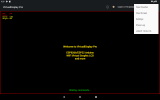Hi programmers,
I had necessity on some situations to use my app on android emulator to connect over wifi to ESP8266/ESP32.
This works, I can estabilish a socket TCP or UDP connection, send and receive data to/from.
Now I have the opposite necessity, I have developed an android app where ESP send UDP (connectionless) packets
to Android but the emulator cannot receive from ESP on my app.
On real device all is working.
What I do not know is the IP address, Android emulator settings and my app says the current IP Address is 10.0.2.16,
this range of IP addresses should be inside a Local Area Network as my short tutorial here:
https://www.b4x.com/android/forum/t...-address-is-private-or-public.144370/#content
I've put 10.0.2.16 in the ESP sketch, ESP send packets but the app on emulator still wait for incoming UDP packets and nothing happen.
I even tried to put the PC IP Address where emulator is, but nothing happen.
Can someone tell me if that is possible ?
Many thanks
I had necessity on some situations to use my app on android emulator to connect over wifi to ESP8266/ESP32.
This works, I can estabilish a socket TCP or UDP connection, send and receive data to/from.
Now I have the opposite necessity, I have developed an android app where ESP send UDP (connectionless) packets
to Android but the emulator cannot receive from ESP on my app.
On real device all is working.
What I do not know is the IP address, Android emulator settings and my app says the current IP Address is 10.0.2.16,
this range of IP addresses should be inside a Local Area Network as my short tutorial here:
https://www.b4x.com/android/forum/t...-address-is-private-or-public.144370/#content
I've put 10.0.2.16 in the ESP sketch, ESP send packets but the app on emulator still wait for incoming UDP packets and nothing happen.
I even tried to put the PC IP Address where emulator is, but nothing happen.
Can someone tell me if that is possible ?
Many thanks
Attachments
Last edited:

